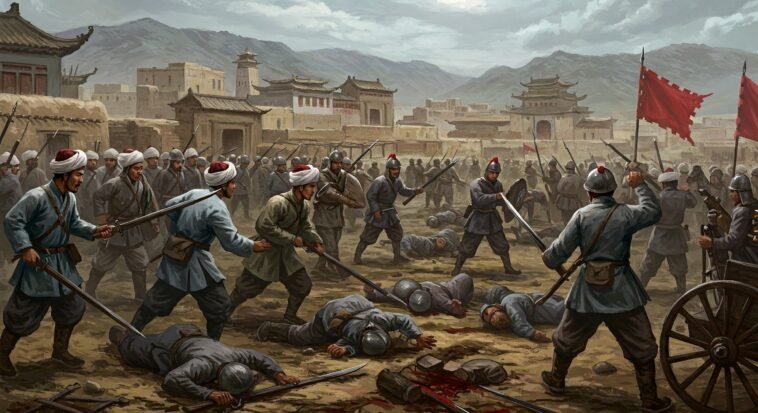
China’s history isn’t just about emperors and dynasties—it’s also about moments of chaos that changed everything.
One such moment?
The Dungan Revolt (1862–1877). This conflict didn’t just shake things up—it reshaped China’s Northwest, from its people to its economy, and still impacts areas like Xinjiang and Gansu today.
Think of it as the Game of Thrones of Chinese history—lots of drama, big consequences, and a lasting influence on the world as we know it.
What Was the Dungan Revolt?
The Dungan Revolt was a series of intense uprisings by Hui Muslims and other ethnic groups against the Qing dynasty in the mid-to-late 19th century.
What started as a mix of ethnic tension, religious divides, and economic hardship quickly spiraled into a brutal civil war with millions of lives lost.
Key facts:
- Timeframe: 1862–1877
- Location: Primarily in Gansu, Shaanxi, Ningxia, and Xinjiang
- Main players: Hui Muslims (aka “Dungan” in Russian sources), Han Chinese, and the Qing military
- Death toll: Estimates vary, but between 8 to 12 million people were killed
It’s like the War of the Roses in China, but with higher stakes and way more complexity.
This conflict wasn’t just about fighting—it reshaped the entire region for generations.
Causes of the Dungan Revolt
Ethnic and religious tensions
The Qing dynasty was Manchu-led, but they backed the Han Chinese majority.
In the Northwest, Hui Muslims lived alongside Han settlers, and that combo was like putting two rival factions in a Game of Thrones episode—clashes over land, taxes, and religious freedoms were inevitable.
Economic hardship
Things got even worse after a series of natural disasters—droughts and famines hit hard.
With resources in short supply, tensions flared, especially between Muslim and non-Muslim communities.
It was like a high-stakes game of survival, with ethnic rivalries making everything worse.
- Read also: The Great Wall of China: 9 Fun Facts for Kids
- Read also: Navigating the Sands of Time: An Ancient Chinese Civilization Timeline
Administrative corruption
Local Qing officials weren’t helping matters.
They discriminated against Muslims, taking advantage of minority communities for their own gain.
It was basically the dark side of bureaucracy: corruption making everything harder, not better.
Spread of militant Islam
As frustrations grew, some Hui leaders turned to militant Islamic teachings.
They saw the revolt as both a religious and political fight for autonomy.
It’s like when a protest movement picks up momentum—what starts as a small spark grows into a fire.

Major Phases of the Revolt
Phase 1: Local outbreaks (1862–1866)
At first, the revolt started small—think of it like a firecracker going off in Shaanxi and Gansu.
Tensions over grain prices and personal grudges led to clashes, but things quickly escalated.
Hui militias, not content with just complaining, took matters into their own hands and started attacking government installations.
Imagine a few sparks turning into a wildfire.
Phase 2: Militarization and expansion (1866–1872)
By now, the revolt spread like wildfire across the Northwest.
Cities were thrown into chaos, and Hui warlords like Ma Hualong set up shop in strategic strongholds like Jinjipu.
Meanwhile, in Xinjiang, the power vacuum left by the chaos gave rise to short-lived kingdoms led by outsiders like Yakub Beg—kind of like the Wild West, but with more political intrigue and less cowboy flair.
Phase 3: Qing retaliation and suppression (1872–1877)
The Qing court had finally realized this was no small rebellion.
They called in General Zuo Zongtang, the ultimate strategist, to handle the mess.
His approach?
A mix of diplomacy, military force, and offering some sweet economic deals.
By 1877, most of the organized resistance was wiped out, but not without significant bloodshed and destruction.
Think of it as the final act in a tense epic—the hero (Qing) comes in strong, but the cost is high.
Impact of the Dungan Revolt on China’s Northwest
The Dungan Revolt didn’t just shake up the region in the short term—it permanently reshaped China’s Northwest.
Here’s how:
Massive depopulation
The revolt left entire towns in ruins.
The death toll was staggering, with regions like Shaanxi losing huge chunks of both Hui and Han populations.
In Gansu alone, the population dropped by nearly 50% (Esherick, 1987).
It was like a natural disaster, but with political chaos mixed in.
Result:
The lands were repopulated, but mostly by Han Chinese from the east.
Surviving Hui communities either fled westward to Central Asia or became sidelined minorities in their own land.
Migration to central Asia
Many Hui refugees crossed into Russian Turkestan (today’s Kazakhstan, Kyrgyzstan, and Uzbekistan), setting up the Dungan communities that still exist there.
This migration wasn’t just about escaping conflict—it created lasting ties between China’s Muslim population and Central Asia (Forbes, 1986).
Talk about global connections before the internet!
Strengthened Qing military presence
The Qing dynasty took notes from this disaster.
They established military garrisons in key cities, encouraged Han migration to dilute Hui populations, and reformed the administrative system to prevent future corruption.
It was a classic “lesson learned the hard way” moment—like putting up extra security after the heist in Ocean’s Eleven.
Creation of Xinjiang province (1884)
In 1884, a few years after the revolt ended, Xinjiang—formerly a semi-autonomous frontier—became an official province.
The Qing dynasty wasn’t playing around anymore; they were serious about integrating the west into their empire.
Think of it like a territorial makeover for the empire.
Enduring ethnic divides
While the Qing crushed the revolt, the distrust between Han and Hui communities was like a bad breakup that never really healed.
The effects are still felt today, with ongoing ethnic tensions and occasional unrest in the Northwest.
It’s the longest-lasting fallout from a conflict that started over a century ago.

Lessons from the Dungan Revolt
The Dungan Revolt may have happened over a century ago, but its lessons still ring true today—especially when it comes to managing diversity, avoiding corruption, and keeping societies peaceful.
Key lessons:
Inclusivity matters
When minorities feel pushed to the margins, it’s like a pressure cooker waiting to blow.
Exclusion breeds resentment, and that resentment can lead to violence.
It’s like trying to ignore the elephant in the room—eventually, it’ll charge.
Economic stability is key
Poverty and scarcity are like gasoline on an already raging fire.
When resources are scarce, ethnic and religious tensions spike.
Think of it as trying to run a Game of Thrones kingdom without enough food—everyone’s gonna fight over what little’s left.
Effective governance
A strong but fair administration is like the glue that holds a diverse empire or nation together.
When officials are corrupt, or leadership turns a blind eye to inequalities, it’s like having a broken compass in a storm—you won’t make it far.
Modern Relevance: Why It Still Matters Today
Fast forward to today, and China’s Northwest, including Xinjiang and parts of Gansu, is still a hotspot for geopolitical drama and domestic concerns.
The region’s history is like a backstage pass to understanding modern policies—especially when it comes to minority integration, economic development, and battling separatism.
The strategies China uses now?
Well, they’ve got roots in the aftermath of the Dungan Revolt.
Here’s why this history still matters:
China’s current ethnic policies
The quest for ethnic harmony in today’s China can be traced back to the lessons of the Dungan Revolt.
Much like trying to fix a leaky pipe without addressing the source, policies today aim to patch up historical divides—though they’re not without controversy.
Belt and Road Initiative (BRI)
The BRI prioritizes stability in regions like Xinjiang.
This is a modern attempt to ensure economic development doesn’t spark new fires like the Dungan Revolt.
Think of it as trying to make sure your remote village gets better Wi-Fi without stirring up old rivalries.
Ongoing human rights debates
International discussions about human rights in Xinjiang are still framed by the region’s turbulent history.
Just as unresolved tensions from the Dungan Revolt shaped the area’s modern struggles, today’s issues can’t be fully understood without recognizing that long legacy.
The Dungan Revolt wasn’t just a flash in the pan—it’s a reminder that unresolved historical wounds can echo through the centuries, shaping a region’s fate long after the dust settles.

- Read also: Russian Revolution Facts: Historical Context and Significance
- Read also: A Timeline of the French Revolution: Key Events from 1787 to 1799
Conclusion: A Forgotten Revolution That Redefined a Region
The Dungan Revolt wasn’t just a Muslim uprising—it was a game-changer for Northwest China.
It reshaped the region’s demographics, politics, and culture in ways that still echo today.
You can trace its impact in Xinjiang’s ethnic makeup, the Dungan communities in Central Asia, and the policies China uses to manage its western borders.
Looking back at the revolt isn’t just about history lessons—it’s about understanding China’s ongoing challenges with its multiethnic society.
Think of it like that plot twist in your favorite show that you totally missed, but it changes everything in the end.



